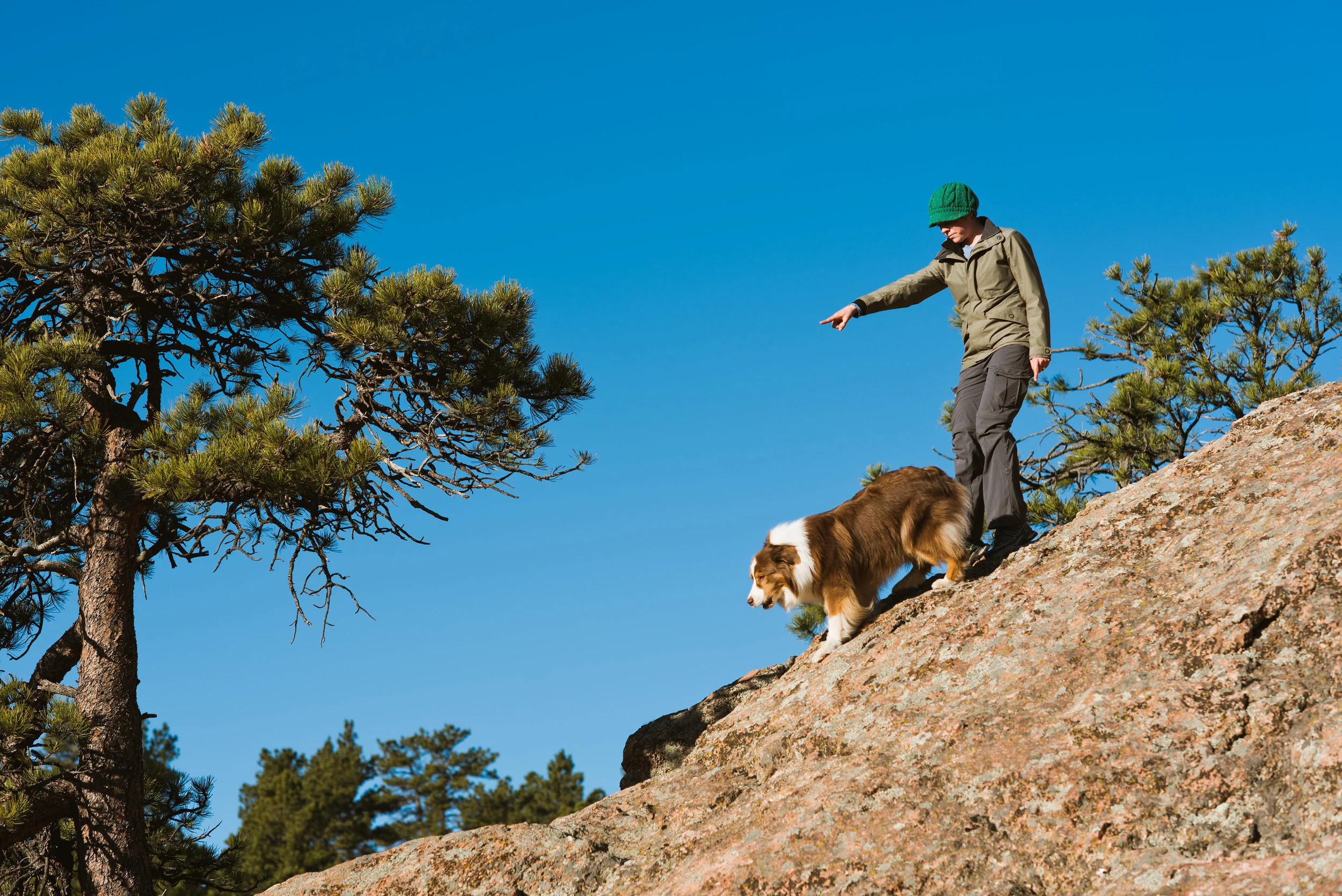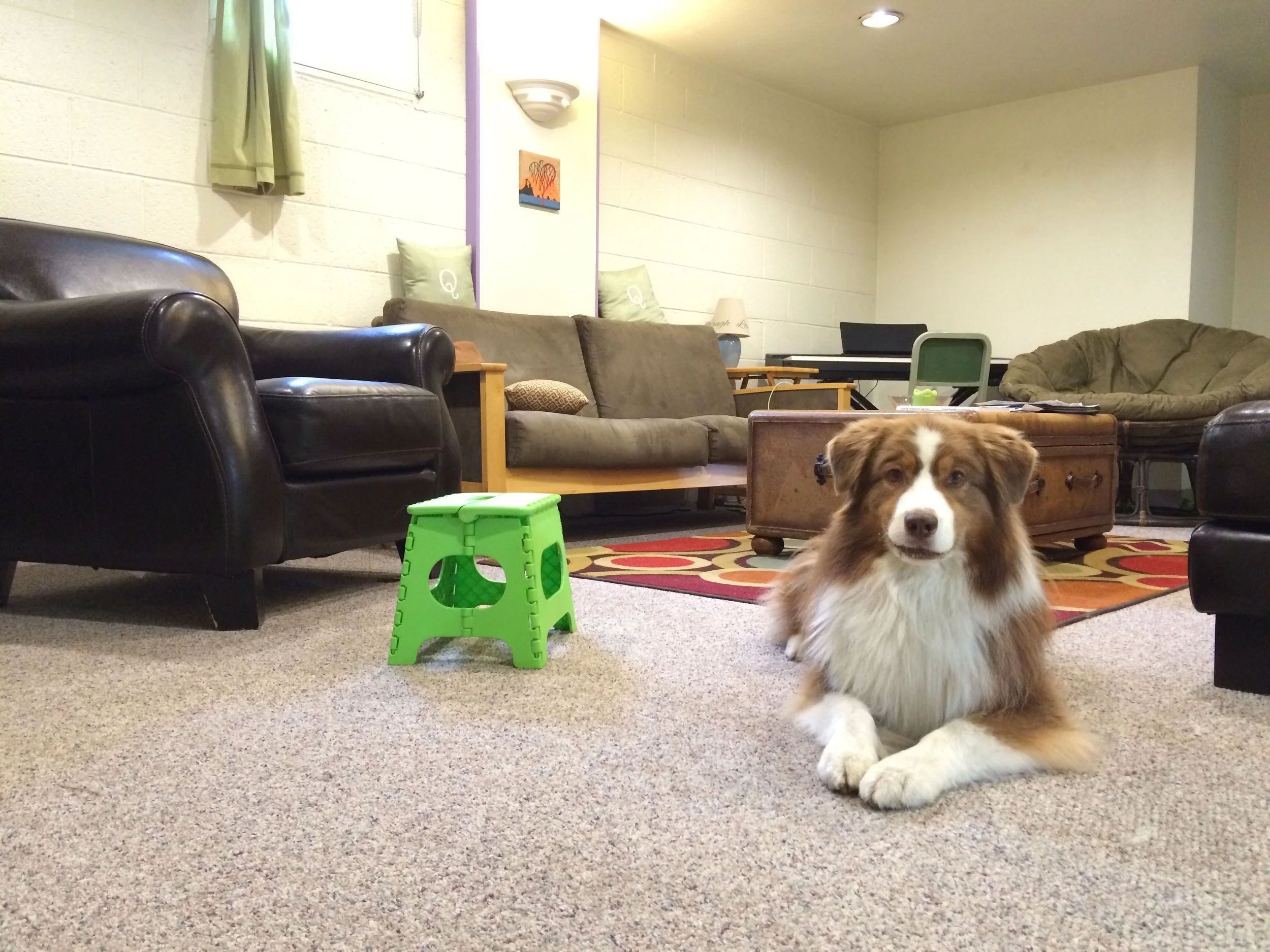Written by Summit Dog Training Associate Trainer Charissa Beaubien
I grew up in the mountains of Salida, Colorado on my family’s farm with horses, chickens, cows, dogs, and cats. My best friend was a hybrid dog named Raydar. Raydar and I spent our childhood adventuring and exploring the Rockies together.
Charissa & Raydar playing dress up.
I think back on my childhood and realize that there were always dogs around; when I had Raydar, we also had four other dogs. I learned a lot about dog communication by watching our five (or more) dogs interact and figure out life together. We never owned leashes or groomed our dogs, the dogs slept inside and ate scraps mixed with what ever else was laying around. Our dogs were treated very well and all lived full long lives but they were always just dogs. They spent most of their day outside laying in the sun or protecting the cows, they also went on adventures when we would go hunting or out to chop wood. In town they followed us around the streets saying hello to other dogs or slept in the truck if we just had to run errands. I remember thinking it was weird that people didn’t take their dogs everywhere with them.
Left to Right: Chance, Honey, Raydar & Annie
I moved to Ohio during my teen years, and there began working professionally with animals in 2009 at a local humane society and soon discovered a passion for helping those in need. I remember this time in my life vividly as I started working at the shelter and soon discovered people treated their animals very differently then I had as a child. They would surrender their old dogs because they just purchased a new puppy. Or people would hurt and abuse their dogs because they were acting like any dog would. I also saw a lot of good people give loving homes to shelter dogs!
While working at the shelter I was able to intern under a "balanced” trainer teaching classes and training the shelter dogs. In that time a skinny pit bull/hound mix named Dylon walked into my life. Dylon had been abandoned and tied to a tree so that his collar had become imbedded and he was diagnosed with acute renal failure due to stress. The shelter’s veterinary team was not optimistic. But Dylon chose me. There had been a handful of dogs I wanted to adopt from the shelter but alas this skinny boy wouldn’t leave me alone. He went home with me as a foster dog were he recovered quickly, and soon after I adopted him. However healthy, Dylon had many behavioral hiccups such as separation anxiety, handling sensitivity, and lack of manners. I was unable to use force or intimidation with Dylon due to his injuries, and this prompted me to began researching positive training methods to use with him.
Meet Dylon!
While I was training under my mentor he told me these methods would never work and that I would never be a good trainer because I was a girl and thus I was not strong enough (mentally or physically) to make a dog respect me. This lit a fire under me to prove him wrong. I knew that by using love and empathy I could build a relationship with an animal and in this way I could teach them new things! Dylon proved that trust was the key to building a lifelong relationship with me, that to this day is unbreakable.
Charissa and Dylon near Red Feather Lakes paddle boarding and looking for Ducks.
Charissa, Dylon, and boyfriend Tyler enjoying Moab’s Red Rock mountains
In 2013 I dedicated my career to progressive positive reinforcement marker-based training. I decided to take Karen Pryor’s Certified Training Partner course and graduated as a certified animal trainer in 2014. I am enthusiastic about continued education and public outreach. In 2015 I received a second animal training certification through CCPDT, becoming a Certified Professional Dog Trainer – Knowledge Assessed. I am currently working towards a Silver Certification in Low Stress Handling.
My current job is at the Humane Society of Weld County as the Behavior Technician, in addition to being the Associate Trainer at Summit Dog Training. I am working to develop the behavior department at the shelter and group classes for the animals in the shelter's care as well as the animals in the community. I also work at CSU as a Colorado State University lab instructor for the first year Veterinary Students teaching low stress handling.
I spend my free time camping and hiking with Dylon and a new addition Arja, a Cornish Rex kitten, in beautiful Fort Collins, CO. My goal is to change myths about shelter dogs and express to owners that compassion, trust, empathy, and fun build lasting human animal bonds. I want to show people that we can allow our dogs to be dogs and that by doing so we are fulfilling their needs and creating behaviorally healthy canines. And that when someone tells you that you can’t, prove them wrong.
Dylan gets cozy on a mountain adventure as the night slows down.

































